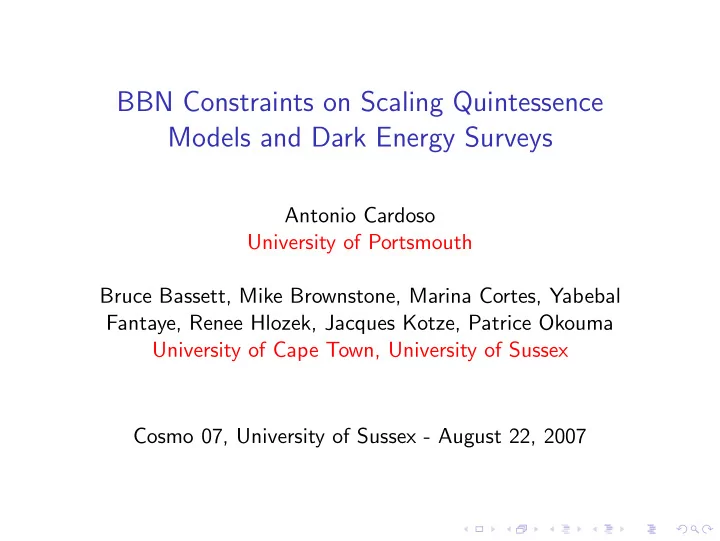

BBN Constraints on Scaling Quintessence Models and Dark Energy Surveys Antonio Cardoso University of Portsmouth Bruce Bassett, Mike Brownstone, Marina Cortes, Yabebal Fantaye, Renee Hlozek, Jacques Kotze, Patrice Okouma University of Cape Town, University of Sussex Cosmo 07, University of Sussex - August 22, 2007
Introduction ◮ The universe is undergoing a period of accelerated expansion driven by an unknown component (dark energy) ◮ A time-independent cosmological constant is consistent with all observations, but it is important to look for alternatives ◮ Consider models where a scalar field scales with the background fluid during the radiation and matter eras, and dominates the energy density of the universe at late times ◮ Big bang nucleosynthesis (BBN) gives a strong constraint on the energy density of dark energy during the radiation era ◮ Investigate whether it is possible to distinguish between scaling models and a cosmological constant with observations
Scaling models Wetterich, 1988 ◮ Exponential potential κ 2 = 8 π G V ( φ ) = M 4 e − λκφ ◮ λ 2 > 3(1 + w b ): scales with the background fluid Ω φ = 3(1 + w b ) /λ 2 w φ = p φ /ρ φ = w b ◮ λ 2 < 3(1 + w b ): dominant component of the universe w φ = − 1 + λ 2 / 3 Ω φ = 1 ρ c = 3 H 2 / 8 π G Ω φ = ρ φ /ρ c
Constraints from BBN ◮ The presence of a scalar field changes the expansion rate of the universe at a given temperature ◮ Affects the abundance of light elements at the time of nucleosynthesis ◮ Constraint on Ω φ during the radiation dominated era Bean, Hansen and Melchiorri, 2001 Ω φ ( T ∼ 1 MeV ) < 0 . 045 ◮ Constraint on the value of λ (in the scaling regime) 4 λ 2 > λ � 9 . 43 ⇒ 0 . 045
Polynomial w ( z ) parametrization ◮ Scaling until z t and w ( z ) = w 0 + w 1 z + w 2 z 2 in the region 0 ≤ z < z t ◮ Assume w ( z t ) = w m = 0 and w (0) = − 1 � 1 − w 1 � z 2 w ( z ) = − 1 + w 1 z + z 2 z t t Ω (0) DE f ( z t ) Ω DE ( z t ) = m (1 + z t ) 3 = 0 . 045 Ω (0) DE f ( z t ) + Ω (0) � z � 1 + w ( z ′ ) � dz ′ f ( z ) = exp 3 1 + z ′ 0 ◮ Solve w 1 as a function of z t ◮ Use BBN bound to maximise deviations from Λ
Polynomial w ( z ) parametrization ◮ Need the constraint w ( z ) > − 1 for all z to describe a canonical scalar field 0 H DE (z)/H Λ CDM 1.025 w(z) −0.2 1.02 −0.4 1.015 −0.6 1.01 −0.8 1.005 −1 1 0.1 1 10 0.01 0.1 1 10 z z ◮ � 2 . 7% deviations of H ( z ) from ΛCDM ◮ Largest deviation occurs at z ∼ 2
Polynomial w ( z ) parametrization � d DE � z ( z ) � dz ′ ◮ ∆ µ ( z ) = 5 log 10 L d L ( z ) = (1 + z ) d Λ CDM 0 H ( z ′ ) ( z ) L 0.04 ∆µ (z) 0.02 0 −0.02 −0.04 −0.06 0 0.5 1 1.5 2 z ◮ Predicted errors in the DETF report for Stage III (blue) and Stage IV (black) surveys Albrecht et al, 2006
Double exponential potential ◮ Potential with two exponential terms Barreiro, Copeland and Nunes, 2000 1 e − λκφ + M 4 V ( φ ) = M 4 2 e − µκφ ◮ Scales during the radiation and matter epochs and dominates at late times ◮ Need µ 2 < 2 to have acceleration and M 2 such that Ω (0) ∼ 0 . 7 and Ω (0) m ∼ 0 . 3 φ ◮ Evolution equations φ + 3 H ˙ ¨ φ + V ,φ = 0 ρ m + 3 H ρ m = 0 ˙ ρ r + 4 H ρ r = 0 ˙ H 2 = κ 2 � 1 � φ 2 + V ( φ ) + ρ m + ρ r ˙ 3 2
Double exponential potential 1 e − λκφ + M 4 ◮ V ( φ ) = M 4 2 e − µκφ w(0) = −0.8 0 1.05 H DE (z)/H Λ CDM w(z) −0.2 1.04 −0.4 1.03 w(0) < −0.9 −0.6 1.02 −0.8 1.01 −1 1 0.1 1 10 0.01 0.1 1 10 z z ◮ w φ (0) � − 0 . 9 implies � 2 . 7% deviations of H ( z ) from ΛCDM ◮ Largest deviation occurs at z ∼ 1
Double exponential potential 0.05 ∆µ (z) 0 −0.05 −0.1 0 0.5 1 1.5 2 z ◮ Predicted errors in the DETF report for Stage III (blue) and Stage IV (black) surveys Albrecht et al, 2006
Conclusions ◮ Constraints on the energy density of the scalar field at the time of BBN strongly limit scaling quintessence models ◮ Tracking quintessence dynamics may be effectively invisible until the unveiling of Stage-IV dark energy experiments (JDEM, LSST, SKA) ◮ Tracking scalar field models are well motivated alternatives to the cosmological constant as the source of cosmic acceleration today ◮ Dark energy may well be dynamical even if we do not detect such dynamics in the next decade
Recommend
More recommend